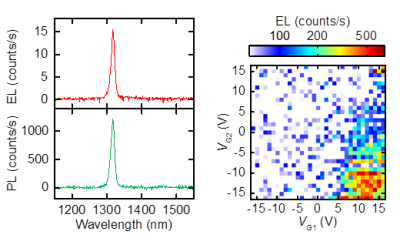Research:Cold exciton electroluminescence from air-suspended carbon nanotube split-gate devices
It is possible to observe electroluminescence from single-walled carbon nanotubes by injecting electrons and holes using electrical contacts. Since photoluminescence becomes weak when nanotubes are on the substrate, we have fabricated light emitting diode utilizing individual air-suspended carbon nanotubes.

In this device, the top silicon layer of a silicon-on-insulator substrate is used for split gates. By applying opposite polarity voltages to the two gates, a p-n junction is formed due to accumulation of electrons and holes. Application of a bias voltage across source and drain electrodes will result in light emission.

The top-left figure shows electroluminescence (EL) and photoluminescence (PL) spectra from a suspended nanotube. As the emission wavelengths are the same, we assign the emission to exciton recombination.
The top-right figure shows gate voltage dependence of electroluminescence intensity. The horizontal axis is the voltage VG1 applied to Gate 1, while the vertical axis is the voltage VG2 applied to Gate 2. Electroluminescence is observed in the region where VG1 is positive and VG2 is negative, where a forward-biased p-n junction should be formed.
To learn more about this work, please refer to:
Cold exciton electroluminescence from air-suspended carbon nanotube split-gate devices
Appl. Phys. Lett.
110, 191101 (2017).
![]()